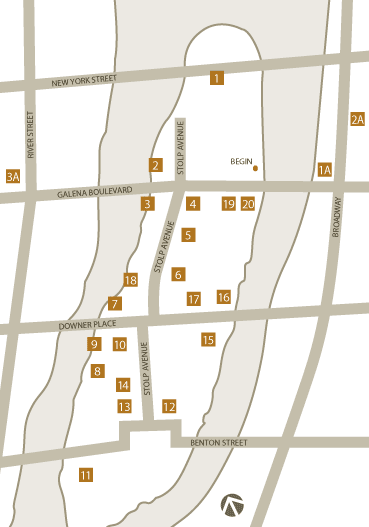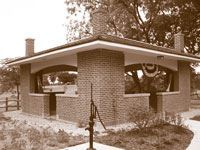
Location: Galena Boulevard, Stolp Avenue, Downer Place - Aurora, IL 60505
The historic machine shops of this pre-Civil War railroad complex have been renovated into a multi-modal regional transportation center. Metra tickets to Chicago, food, beverage, and retail services are on site.
Location: Aurora Transportation Center, 223 N Broadway (Route 25), Aurora, IL 60505
The former C.B. and Q. Roundhouse adjacent to the Transportation Center dates from 1855 to 1865, and is the only standing full stone roundhouse in the U.S. It was listed individually on the National Register of Historic Places. The Roundhouse was an architectural ruin when Walter Payton and his partners renovated the building in 1996. On October 22, 1999, it was selected by the National Trust for Historic Preservation as one of the nation's top rehabilitated buildings.
The Two Brothers Roundhouse Complex features America's Brewpub restaurant, a microbrewery, an outdoor courtyard for summer concerts, banquet facilities, and more! Many of the former employees of the C.B. & Q. are memorialized with commemorative bricks in the courtyard. Aurorans from many nationalities worked in these historic facilities, including Irish, German, Luxembourger, African, Romanian, and Mexican.
Location: Aurora Transportation Center, 223 N Broadway (Route 25), Aurora, IL 60505
The old Central Fire Station is viewed by most Aurorans as the most significant, tangible reminder of the City's long tradition of fire fighting. The first organized fire protection came in 1856 with Jesse Brady's formation of a volunteer company. Part-time paid firefighters were hired in 1882. The central fire station was constructed in 1894, and designed by J.E. Minott in the Victorian Commercial style.
Stripped of all the Victorian details in 1943 when a permit was sought for "flattening" the building's front bay windows, the building was fully restored to its original character in 2003. This included the restoration of the bay windows with leaded glass transoms, installation of a replica onion dome, and new doors to match the originals. During the restoration, oats were still found between the floorboards as horses were housed in the building until 1916. Automotive fire trucks were then purchased and the horses put out to pasture! The building is now open to the public.
Location: Aurora Regional Fire Museum, 51 N. Broadway, Aurora, IL 60505
The original town square of the Village of Aurora, McCarty Park was platted in 1835. In 1987, as part of Aurora's Sesquicentennial Celebration, the park was restored. It originally featured a Victorian fountain and gazebo. Theodore Roosevelt spoke here in 1903 during his presidency.
Location: Between E. Park Place and W. Park Place, Galena Boulevard and New York Street, Aurora, IL 60505
This museum features a complete historic perspective of the African American experience by way of sculptured art by Dr. Charles Smith. Outdoor exhibits are on display. For more information call 815-968-9770.
Location: 126 S. Kendall, Aurora, IL 60505

The Lincoln Highway Shelter is one of the original auto-camps constructed along the highway that offered those traveling on a budget an appealing alternative to a hotel stay. Opportunistic civic boosters often established such facilities to promote good reputations for their towns and entice the increasing number of auto travelers to stay and buy groceries and gas. The Shelter at Phillips Park was constructed in 1923 by the Aurora Automobile Club, and the 1924 edition of the Complete Official Road Guide of the Lincoln Highway noted that this new "free camping ground at the City Park" had 2 fireplaces, 2 ovens and a sink in addition to a "good well of pure drinking water just outside the building."
The Lincoln Highway Association is dedicated to keeping the highway in the public consciousness and preserving the few remaining stretches of the original highway. In 2000, the Illinois portion was designated a National Scenic Byway by the U.S. Department of Transportation, leading many modern-day auto-tourists to rediscover the joy and adventure of traveling off the beaten path.
Location: Route 30 (Hill Avenue), near Phillips Park Golf Course Entrance, Aurora, IL 60505

Enter the park by turning right on H.A. Wyeth Sr. Drive from Smith Boulevard.
As early as 1835 this wooded, hilly area was used for picnics and family outings. The Aurora Sharp Shooter Society used it for a shooting range in the early 1870s. In 1899, 60 acres were purchased by the estate of former Mayor Travis Phillips and donated to the City as City Park. In 1902, the park was renamed Phillips Park in his honor.
Now located on more than 300 acres, the park features a unique Oak and Hickory Forest, the recently renovated Sunken Garden, an 18-hole golf course, zoo, aquatic center, and tennis courts. Mastodon bones were discovered when the lake was created in the 1930s as a Civil Works Administration project. Named after the mammal, the 25-acre Mastodon Lake is surrounded by a one-mile multiple use trail. Other amenities in the park include the entry waterfall, World War One cannons and veteran related monuments, playground, picnic pavilions, and volleyball courts. Parking for Mastodon Lake, trail and zoo is located on Wyeth Drive. For the other features, parking is available by turning left on to Ray Moses Drive to the parking lot on the right.
Location: Phillips Park, Smith Boulevard and Ray Moses Circle Drive
Aurora University was founded in 1893 by the Advent Christian Church. The 3 main buildings on the campus date from 1912 and are listed on the National Register. The private university offers undergraduate and graduate degrees to its current enrollment of about 3000 students. The Schingoethe Center for Native American Cultures is also located at the University. The Center houses artifacts from North American tribes.
Location: Gladstone Avenue and Marseillaise Place
One of the most significant homes in Aurora is the Ford house, designed by architect Bruce Goff. It is also commonly referred to as the "Round" or "Coal" house. Working on the theory that the circle is "an informal, gathering-around, friendly form," Goff designed the home with a center circle 50 feet in diameter and two circular bedroom wings. It is constructed of anthracite coal, steel, glass, cedar, and hemp, and has remained relatively unchanged since its construction. Bruce Goff was a self-educated and exceptionally creative architect. His organic designs often depended on creative free-association and borrowed materials. Ruth Van Sickle Ford was the original owner. She was a noted artist, and was the director of the Chicago Academy of Fine Arts at the time the house was constructed.
Location: 404 S. Edgelawn Drive, Aurora, IL 60505
These homes were constructed in 1949 in response to a need for G.I. housing after WWII. They were produced on an assembly line and made of porcelain enamel on steel (like the inside of an oven). The homes are practically maintenance free. Only 3,000 Lustron homes were manufactured in the U.S. before the government-backed loans to finance the company were called.
Location: 119, 34, 32, 16 Rosedale Avenue, Aurora, IL 60505
The Greene House is the only house in Aurora designed by Frank Lloyd Wright. Constructed in the Prairie style of architecture, it was at that time the smallest home that Wright designed. William B. Greene was one of the founders of the Barber-Greene Equipment Company. His college friend, Harry Robinson, was one of Wright's draftsmen, and Greene posed the question with Harry as to Wright's possible interest in a very modest home on his lot. Wright was indeed interested.
Greene stated that home building was then slack, and Wright had fallen into disfavor with the public following the abandonment of his wife and 6 children for another woman. His friend Harry came out to the site to learn their requirements. They then reviewed other Wright plans and sketches which were all too elaborate. They preferred the gable roof over the flat roof, liked the casement windows and fireplace.
In 1926, Robinson designed an addition to the west of the original house. Mr. and Mrs. Greene later built a Usonian retirement home behind their original Wright home in 1958.
Location: 1300 Garfield Avenue, Aurora, IL 60505
Constructed in 1856 in the Italianate style, the Tanner mansion is listed on the National Register of Historic places and located in the Tanner Historic District. The Tanner family came to the area in 1837, and built this home with 8 bedrooms for their 9 children. The showplace of the Aurora Historical Society, the Tanner Mansion features an octagon cupola and ornate wooden brackets. On the interior, period Victorian room settings are on display. It is open to the public and there is a fee.
Location: Oak Avenue and Cedar Street, Aurora, IL 60505
The Mighell house was featured in the 1913 to 1914 Craftsman magazine. It was designed by Worst and Shepardson, with Frank Packard, associate architect. Constructed of locally quarried limestone, the mortar was raked to a 2-inch depth to appear to have crumbled with age.
Above the windows are hand-hew oak timbers taken from an old barn that had stood on the premises for 75 years. The original roof was a dull red tile, heavily splotched with moss green. Faint remnants of the original landscape design by Jens Jensen are still evident, such as the limestone gate and boathouse.
Location: 495 N. Lake Street, Aurora, IL 60505